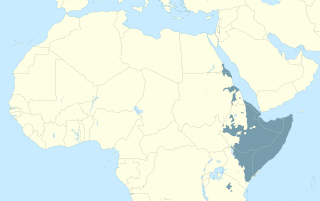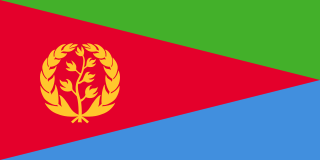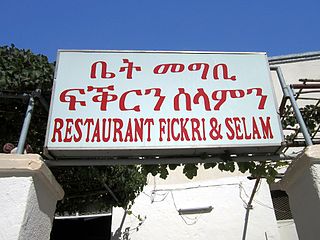
The Cushitic languages are a branch of the Afroasiatic language family. They are spoken primarily in the Horn of Africa, with minorities speaking Cushitic languages to the north in Egypt and Sudan, and to the south in Kenya and Tanzania. As of 2012, the Cushitic languages with over one million speakers were Oromo, Somali, Beja, Afar, Hadiyya, Kambaata, and Sidama.

Sources disagree as to the current population of Eritrea, with some proposing numbers as low as 3.6 million and others as high as 6.7 million. Eritrea has never conducted an official government census.

The Beja people are a Cushitic ethnic group native to the Eastern Desert, inhabiting a coastal area from southeastern Egypt through eastern Sudan and into northwestern Eritrea. They are descended from peoples who have inhabited the area since 4000 BC or earlier, although they were Arabized by Arabs who settled in the region. They are nomadic and live primarily in the Eastern Desert. The Beja number around 1,900,000 to 2,759,000.
Beja is an Afroasiatic language of the Cushitic branch spoken on the western coast of the Red Sea by the Beja people. Its speakers inhabit parts of Egypt, Sudan and Eritrea. In 2022 there were 2,550,000 Beja speakers in Sudan, and 121,000 Beja speakers in Eritrea according to Ethnologue. As of 2023 there are an estimated 88,000 Beja speakers in Egypt. The total number of speakers in all three countries is 2,759,000.

The Rashaida, also known as Bani Rasheed, are a Bedouin ethnic group inhabiting the coastal plain of the Red Sea stretching from the Sudanese city of Port Sudan to the Eritrean city of Massawa. They are the descendants of Arab tribes people from Hejaz, and Najd decending from the Banu Abs tribe, who fled the Arabian peninsula in 1846 as the Saudis rose to power. They are mostly nomadic and constitute 187,500 people in Eritrea and 168,000 people in Sudan, mainly in the eastern part around Kassala.
Amarar is a nomadic tribe of the Beja people inhabiting the mountainous country to the west of the Red Sea, Suakin northwards, and Eritrea towards Sudan. Between them and the Nile are the Ababda and Bisharin Beja tribes and to their south dwell the Hadendoa. The country of the Amarar is called the Atbai. Their main location is in the Ariab region. The tribe is divided into four great families: (1) Weled Gwilei, (2) Weled Aliab, (3) Weled Kurbab Wagadab, and (4) the Amarar proper of the Ariab district. They are said to be of Quraysh blood through Ammar Aqiili and to be the descendants of an invading Arab army. The Amarar speak a form of the Beja language that uses fewer loanwords than other groups that speak Beja.

The Bishari are a Cushitic ethnic group who live in parts of Northeast Africa. They are one of the major divisions of the Beja people. Apart from local dialects of Arabic, the Bishari speak the Beja language, which belongs to the Afroasiatic family of the Cushitic branch.

The Bilen are a Cushitic ethnic group in Eritrea. They are primarily concentrated in central Eritrea, in and around the city of Keren and further south toward Asmara, the nation's capital. They are split into two sub-tribes; Bet Tarqe, Bet Tawqe which are split into further clans known as Hissat. The Tawke has six whereas the Tarke has five which each are divided into smaller kinship groups.

The Kunama are an ethnic group native to Eritrea. They are one of the smallest ethnic communities in Eritrea, constituting only 4% of the population. Most of the estimated 260,000 Kunama live in the remote and isolated area between the Gash and Setit rivers near the border with Ethiopia. The Kunama people have ancient ancestry in the land of Eritrea. In the 2007 Ethiopian census, however, the number of Kunama in Tigray has dropped to 2,976 as the remaining 2,000 or so members of this ethnic group have migrated into the other regions of Ethiopia.

The Saho are a Cushitic ethnic group who inhabit large sections of Eritrea and northern Ethiopia. They speak Saho as a mother tongue.

The Beni-Amer, also known as Beni-Amir, are a population inhabiting northeast Africa. They are considered by some to comprise a subgroup of the Beja people. They live in Sudan and Eritrea. They are mostly Muslim and constitute the largest tribal confederation in Eritrea.
The Tigre people are an ethnic group indigenous to Eritrea. They mainly inhabit the lowlands and northern highlands of Eritrea, with a small population in Sudan.

The main languages spoken in Eritrea are Tigrinya, Tigre, Kunama, Bilen, Nara, Saho, Afar, and Beja. The country's working languages are Tigrinya, Arabic, English, and formely Italian.

Tigrayans are a Semitic-speaking ethnic group indigenous to the Tigray Region of northern Ethiopia. They speak the Tigrinya language, an Afroasiatic language belonging to the Ethiopian Semitic branch.

The Nara are an ethnic group inhabiting southwestern Eritrea. The society is divided into four subtribes, who are traditionally animist. They are mostly subsistence farmers.
Articles related to Eritrea include:

Sudan is a multilingual country dominated by Sudanese Arabic. In the 2005 constitution of the Republic of Sudan, the official languages of Sudan are Literary Arabic and English.

Eritreans are the native inhabitants of Eritrea, as well as the global diaspora of Eritrea. Eritreans constitute several component ethnic groups, some of which are related to ethnic groups that make up the Ethiopian people in neighboring Ethiopia and people groups in other parts of the Horn of Africa. Nine of these component ethnic groups are officially recognized by the Government of Eritrea.

Religion in Eritrea consists of a number of faiths. The two major religions in Eritrea are Christianity and Islam. However, the number of adherents of each faith is subject to debate. Estimates of the Christian share of the population range from 47% and 63%, while estimates of the Muslim share of the population range from 37% to 52%.

Cushitic-speaking peoples are the ethnolinguistic groups who speak Cushitic languages natively. Today, Cushitic languages are spoken primarily in the Horn of Africa, with minorities speaking Cushitic languages to the north and south in Egypt, Sudan, Kenya, and Tanzania.
















